Related Research Articles
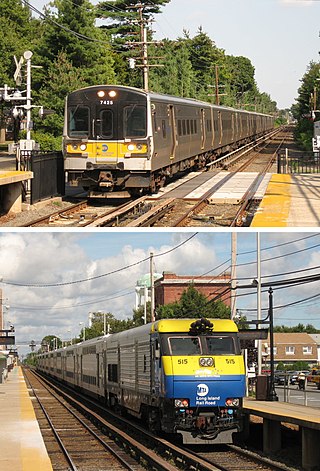
The Long Island Rail Road, often abbreviated as the LIRR, is a railroad in the southeastern part of the U.S. state of New York, stretching from Manhattan to the eastern tip of Suffolk County on Long Island. The railroad currently operates a public commuter rail service, with its freight operations contracted to the New York and Atlantic Railway. With an average weekday ridership of 354,800 passengers in 2016, it is the busiest commuter railroad in North America. It is also one of the world's few commuter systems that runs 24/7 year-round. It is publicly owned by the Metropolitan Transportation Authority, which refers to it as MTA Long Island Rail Road. In 2022, the system had a ridership of 70,342,700, or about 253,800 per weekday as of the third quarter of 2023.
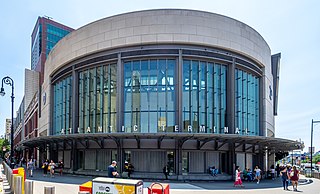
The Atlantic Terminal is the westernmost commuter rail terminal on the Long Island Rail Road's (LIRR) Atlantic Branch, located at Flatbush Avenue and Atlantic Avenue in Downtown Brooklyn, New York City. It is the primary terminal for the West Hempstead Branch, and a peak-hour terminal for some trains on the Hempstead Branch, Far Rockaway Branch, Long Beach Branch, Port Jefferson Branch, Babylon Branch and Ronkonkoma Branch; most other service is provided by frequent shuttles to Jamaica station. The terminal is located in the City Terminal Zone, the LIRR's Zone 1, and thus part of the CityTicket program.
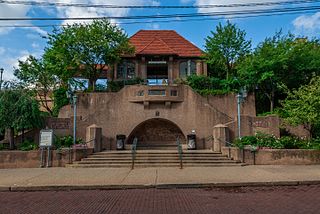
The Forest Hills station is a station on the Main Line of the Long Island Rail Road (LIRR), located in the Forest Hills neighborhood of Queens in New York City. It is lightly used compared to other stations in the city, with only 1,967 weekday riders; many residents opt for the subway because of its more frequent service, cheaper fares, and direct express trains to Midtown Manhattan. The station is wheelchair accessible.

The City Terminal Zone is the set of Long Island Rail Road lines within New York City west of Jamaica station, except the Port Washington Branch.

The Babylon Branch is a rail service operated by the Long Island Rail Road in the U.S. state of New York. The term refers to the trains serving Montauk Branch stations from Valley Stream east to Babylon; in other words, the Babylon Branch is a rail service rather than an actual track. The electrification of the Montauk Branch ends east of the Babylon station, so the Babylon Branch is mostly served by electric trains.

The Montauk Branch is a rail line owned and operated by the Long Island Rail Road in the U.S. state of New York. The line runs the length of Long Island, 115 miles (185 km) from Long Island City to Montauk. However, in LIRR maps and schedules for public use, the term Montauk Branch refers to the line east of Babylon; service from Jamaica to Babylon is covered by separate Babylon Branch schedules, while the line west of Jamaica is currently unused for passenger service. A select number of Montauk Branch trains operate via the Main Line during peak hours.
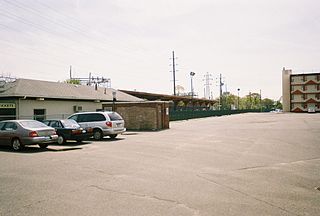
The West Hempstead Branch is an electrified rail line owned and operated by the Long Island Rail Road (LIRR) in the U.S. state of New York. It runs between Valley Stream, New York, and West Hempstead, New York.

The Hempstead Branch is an electrified rail line and service owned and operated by the Long Island Rail Road in the U.S. state of New York. The branch begins at the Main Line at Queens Interlocking, just east of Queens Village station. It parallels the Main Line past Bellerose to Floral Park, where it splits southward and continues east via the village of Garden City to Hempstead Crossing. There it turns south to the final two stations, Country Life Press and Hempstead.

Kew Gardens is a station on the Main Line of the Long Island Rail Road (LIRR). It is located in the Kew Gardens neighborhood of Queens, New York City, near Austin Street and Lefferts Boulevard. The station is located within the City Terminal Zone, part of LIRR fare zone 1. It contains four tracks and two side platforms for the outermost tracks.

The Central Branch is a rail line owned and operated by the Long Island Rail Road (LIRR) in the U.S. state of New York, extending from 40.734°N 73.470°W just east of Bethpage station to 40.696°N 73.341°W just west of Babylon station. It was built in 1873 as part of the Babylon Extension of the Central Railroad of Long Island (CRRLI), which was owned by Alexander Turney Stewart. The branch was mostly unused following the 1876 merger of the CRRLI and the LIRR, but in 1925 it was rebuilt and reconfigured to connect Bethpage and Babylon stations.
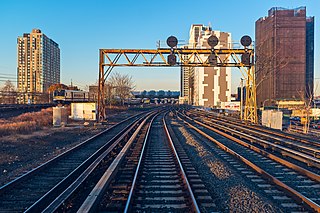
The Main Line is a rail line owned and operated by the Long Island Rail Road in the U.S. state of New York. It begins as a two-track line at Long Island City station in Long Island City, Queens, and runs along the middle of Long Island about 95 miles (153 km) to Greenport station in Greenport, Suffolk County. At Harold Interlocking approximately one mile east of Long Island City, the tracks from the East River Tunnels and 63rd Street Tunnel into Manhattan intersect with the Main Line, which most trains use rather than continuing to Long Island City station.

The Rockville Centre station is a station along the Babylon Branch of the Long Island Rail Road. It is officially at North Village Avenue and Front Street north of Sunrise Highway in Rockville Centre, New York, but the station property spreads west to North Center Avenue and east to North Park Avenue. Parking is available throughout the Village of Rockville Centre, near the station for those with residential and non-residential permits. The station is east of the former Rockville Centre Bus Depot. The station is 21.1 miles (34.0 km) from Penn Station.
Central Railroad of Long Island was built on Long Island, New York, by Alexander Turney Stewart, who was also the founder of Garden City. The railroad was established in 1871, then merged with the Flushing and North Side Railroad in 1874 to form the Flushing, North Shore and Central Railroad. It was finally acquired by the Long Island Rail Road in 1876 and divided into separate branches. Despite its short existence, the CRRLI had a major impact on railroading and development on Long Island.

The M7 is an electric multiple unit railroad car built by Bombardier, with delivery beginning in 2002, used by the MTA on the Long Island Rail Road (M7) and Metro-North Railroad (M7A). The M7 replaced the M1 railcars, which had previously provided electric service on these lines. The M7 fleets are powered from an electric third rail. A total of 1,172 M7 cars were built for the two railroads.
On February 17, 1950, two Long Island Rail Road trains collided on the Montauk Branch just west of Rockville Centre station in Rockville Centre, New York, killing 32 and injuring several dozen more. At the time, it was the deadliest collision in the railroad's history until the Kew Gardens train crash later that year. The crash was a head-on collision involving two trains, which were running along the same gauntlet track due to construction.

On the evening of January 13, 1882, a southbound New York Central passenger train crashed into the rear of another one stopped on the tracks along Spuyten Duyvil Creek in the similarly-named neighborhood of the New York City borough of The Bronx. Eight people were killed, and 19 seriously injured, by the crash and fires afterwards, fires that neighborhood residents and crew extinguished by rolling large snowballs into them until local firefighters arrived. Among the dead was State Senator Webster Wagner, inventor of the sleeping cars used on the train, two of which he was crushed to death between, and a newlywed couple who died together after the bride refused to allow a rescuer to cut her clothing so she could escape. It was the deadliest rail accident in New York City at that time, remaining so for another 20 years.
References
- 1 2 Doyle, Dennis. "Long Island Rail Road's Worst Train Crash- The Richmond Hill Historical Society". Richmond Hill Historical Society. Retrieved September 18, 2018.
- 1 2 3 4 5 "Cars Telescoped; Scenes at Fatal Long Island Rail Road Train Crash in Richmond Hill" . The New York Times . November 23, 1950. p. 1. Retrieved September 18, 2018.
- 1 2 3 Schlegel, Harry (November 23, 1950). "75 Die in L.I. train crash" . New York Daily News. Retrieved September 18, 2018.
- ↑ "LIRR Wrecks". Long Island Rail Road Photos, Maps, and History. July 10, 1909. Retrieved September 18, 2018.
- 1 2 3 4 5 "A Picture History of Kew Gardens, NY". The 1950 LIRR Crash at Kew Gardens/Richmond Hill. November 22, 1950. Retrieved September 18, 2018.
- 1 2 Hausner, Edward (November 23, 1950). "75 Known Dead in L.I. Wreck in Richmond Hill; Toll Mounting in Crash of Eastbound Express Into Standing Train; Cause is Undetermined; at the Scene of Long Island Train Wreck; Floodlights Etch Scene of Tragedy" . The New York Times . p. 1. Retrieved September 18, 2018.
- 1 2 Marka, B. John; United Press (November 24, 1950). "The 1950 Richmond Hill /Kew Gardens Long Island Railroad Train Wreck". A Picture History of Kew Gardens, NY. Retrieved September 18, 2018.
- ↑ "All Boroughs Send Aid to Crash Scene; Police and Fire Rescue Squads Called From Throughout City to Aid Injured" . The New York Times . November 23, 1950. p. 20. Retrieved September 18, 2018.
- ↑ Parke, Richard H. (November 24, 1950). "4-Way Investigation Starts Into Long Island Rail Wreck; Toll Now 77 Dead, 153 Injured; Survivors Receiving Aid and Two Heroes of Tragedy" . The New York Times . p. 1. Retrieved September 18, 2018.
- 1 2 "P.S.C.'s Recommendations Concerning the Long Island Rail Road; Facts Bearing Upon Safety of Operation in General" . The New York Times . January 5, 1951. p. 13. Retrieved September 18, 2018.
- ↑ "Past LIRR accidents through the years". Newsday. June 14, 2017. Archived from the original on September 18, 2018. Retrieved September 18, 2018.
- ↑ Feinberg, Alexander (December 27, 1950). "$6,000,000 Safety Program Set by Long Island Rail Road; L. I. Road to Spend Millions on Safety" . The New York Times . p. 1. Retrieved September 18, 2018.
- ↑ "New Safety Device for Long Island Rail Road" . The New York Times . May 25, 1951. p. 29. Retrieved September 18, 2018.
- ↑ Furfaro, Danielle; Italiano, Laura (September 19, 2017). "This horrific, deadly train wreck sparked the creation of the MTA". New York Post. Retrieved January 15, 2024.